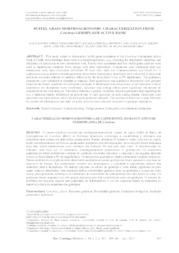Buffel grass morphoagronomic characterization from cenchrus germplasm active bank.
Buffel grass morphoagronomic characterization from cenchrus germplasm active bank.
Autoria: BRUNO, L. R. G. P.; ANTONIO, R. P.; ASSIS, J. G. de A.; MOREIRA, J. N.; LIRA, I. C. de S. A.
Resumo: This study aimed to characterize buffel grass accessions of the Cenchrus Germplasm Active Bank (CGAB) from Embrapa Semi-Arid in a morphoagronomic way, checking the descriptors variability and efficiency in accessions on two consecutive cuts. Twenty-five accessions and five buffel grass cultivars were used in randomized complete block design with three replications. Evaluations were conducted after two consecutive cuts, each evaluation performed 90 days after each cut. Characterization was based on 15 quantitative and qualitative morphoagronomic descriptors. Quantitative descriptors were subjected to individual and joint univariate analysis of variance, followed by the Scott-Knott?s test at 5% significance. Yet qualitative descriptors were submitted to descriptive analysis. Both quantitative and qualitative descriptors were grouped based on the Gower algorithm for divergence analysis. A dendrogram and calculations of the characters relative importance for divergence were established. Genotype and cutting effects were significant for almost all descriptors in the joint analysis. This result indicates a genetic variability between genotypes and, regarding the cut, it indicates mainly differences in growth rate of each genotype in each cutting season. Genotypes were separated into three groups, which showed good genotype variation. The number of tillers per clump, followed by number of inflorescence and color of seeds, were the most relevant characters in genotype separation.
Ano de publicação: 2017
Tipo de publicação: Artigo de periódico
Unidade: Embrapa Semiárido
Observações
1 - Por padrão são exibidas publicações dos últimos 20 anos. Para encontrar publicações mais antigas, configure o filtro ano de publicação, colocando o ano a partir do qual você deseja encontrar publicações. O filtro está na coluna da esquerda na busca acima.
2 - Para ler algumas publicações da Embrapa (apenas as que estão em formato ePub), é necessário ter, no celular ou computador, um desses softwares gratuitos. Sistemas Android: Google Play Livros; IOS: iBooks; Windows e Linux: software Calibre.
Acesse outras publicações
Acesse a Base de Dados da Pesquisa Agropecuária (BDPA) para consultar o acervo completo das bibliotecas da Embrapa.

